Linux: Those Who Could Benefit Most, Fear It
Ubuntu Linux is one of the easiest Linux distributions to install and maintain. It will run on most most hardware and the built-in free applications handle e-mail, Web browsing, other Internet functions, and all the standard office needs for word and number crunching. But it still hasn't been accepted widely. Why? It might have something to do with Microsoft FUD (fear, uncertainty, doubt) which, ironically, is the same delaying tactic IBM used to fight Microsoft in the 1980s. It didn't work then and it won't work now. FUD delays acceptance, but can't halt it. The new version of Ubuntu Linux, released in late April, pushes the operating system closer to the point where the average computer user will no longer be able to ignore it.
Start by tweaking Microsoft on your home page. The following images are an animation that appears when you visit the Ubuntu website. Click any of the following images to see a larger view.




It should say Burma Shave here.
One small problem, however: If you try to download a new version of Ubuntu on the day it is released, you might run into a bit of a traffic jam. I had to try several sites before I found one that didn't look like this:
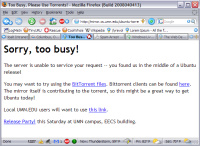
Ahhh ... much better.
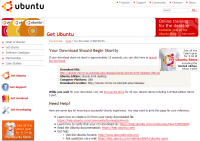
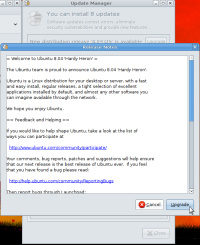 Instead of downloading, I updated. Unlike Microsoft or Apple operating systems, users can upgrade most Linux systems by using the update manager. In this case, Ubuntu 7 detects version 8 in addition to the standard version 7 update packages. It offers me the opportunity to add the version 7 updates or to migrate to version 8.
Instead of downloading, I updated. Unlike Microsoft or Apple operating systems, users can upgrade most Linux systems by using the update manager. In this case, Ubuntu 7 detects version 8 in addition to the standard version 7 update packages. It offers me the opportunity to add the version 7 updates or to migrate to version 8.
I selected version 8.
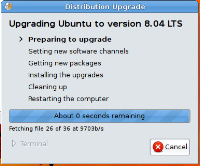 The first part of the process is to download information about the files that are available. That took a few minutes.
The first part of the process is to download information about the files that are available. That took a few minutes.
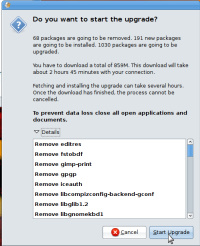 Next, Ubuntu listed the packages that would be updated and told me that the process would download more than 1000 files.
Next, Ubuntu listed the packages that would be updated and told me that the process would download more than 1000 files.
That process would take a little under 3 hours, the installer told me (lying through its teeth.)
Whenever you try to update a Linux application on the day the new version is released, you'll find yourself in a long queue with others who have the same idea.
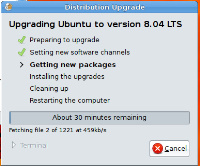 The installer decided to tease me by saying the process should take only 30 minutes, but I knew better.
The installer decided to tease me by saying the process should take only 30 minutes, but I knew better.
Linux users like to make fun of Microsoft and Apple when they estimate how long a process will take. The simple fact is that the estimates are based on the current "instantaneous" download speed and the size the the files remaining to be downloaded. The numbers can be wildly inaccurate and as the download speed changes, the estimate changes.
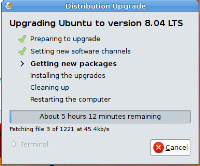 Now the estimate is 5 hours instead of 30 minutes.
Now the estimate is 5 hours instead of 30 minutes.
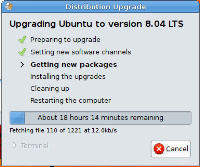 A few minutes later, the estimate was 18 hours. Over the next several hours, the estimate ranged from a low of less than an hour to a 3 days or more.
A few minutes later, the estimate was 18 hours. Over the next several hours, the estimate ranged from a low of less than an hour to a 3 days or more.
After telling me for two hours that the process would take two hours (and after downloading more than 770 files [of 1221]), the installation manager told me that the process would continue for 2 hours 30 minutes, 1 hour 15 minutes, or 3 hours 47 minutes. Or ....? I went to bed.
The next morning, there were a few final tasks that needed my attention.
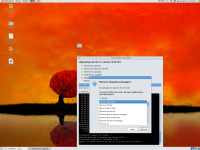 The new components had been installed. All that remained was for me to decide whether I wanted to keep any old packages or remove them.
The new components had been installed. All that remained was for me to decide whether I wanted to keep any old packages or remove them.
I decided to remove them.
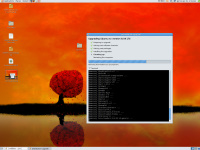 For the next several minutes, file names scrolled by as the updater removed the packages that were no longer needed.
For the next several minutes, file names scrolled by as the updater removed the packages that were no longer needed.
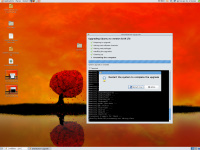 When that process ended, all that remained was to restart the system to finish the switch from Ubuntu 7 to Ubuntu 8. I don't recall the upgrade from Windows 3 to Windows 95 being that easy, nor the upgrade from Windows 95 to Windows 98, nor the upgrade from Windows 98 to Windows 2000, nor the upgrade from Windows 2000 to Windows XP. And certainly not the upgrade from Windows XP to Windows Vista. Apple's upgrades to newer versions of OS X were easier than their Microsoft counterparts, but not as easy as the Ubuntu process.
When that process ended, all that remained was to restart the system to finish the switch from Ubuntu 7 to Ubuntu 8. I don't recall the upgrade from Windows 3 to Windows 95 being that easy, nor the upgrade from Windows 95 to Windows 98, nor the upgrade from Windows 98 to Windows 2000, nor the upgrade from Windows 2000 to Windows XP. And certainly not the upgrade from Windows XP to Windows Vista. Apple's upgrades to newer versions of OS X were easier than their Microsoft counterparts, but not as easy as the Ubuntu process.
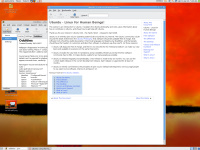 That's it. The upgrade process is complete and most of it occurred without any intervention on my part.
That's it. The upgrade process is complete and most of it occurred without any intervention on my part.
What's New in Ubuntu 8.04 (Hardy Heron) and What's With the Name?
News releases from software publishers always mention the price and availability of new applications. This can create some small challenges when your application isn't available in stores and costs nothing. Still, new news release had a price and availability section: "Ubuntu 8.04 LTS Desktop Edition is free of charge and available on Thursday from http://www.ubuntu.com/download."
Oddly, one of the features promoted most heavily in Ubuntu 8 is a piece of beta software: "It includes the latest, stable version of many core products," the news release says and then notes that Mozilla Firefox 3 (beta 5) is included. "Beta" and "stable" are rarely used in the same sentence and I don't consider Firefox 3 beta 5 to be "stable" because it still crashes too often and many add-ins for version 2 don't work with version 3. (This week Firefox 3 RC 1 was released; that story is in Nerdly News.)
But that's not all, of course. The default photo manager, F-Spot, has been updated and this version of Linux is said to work better with cameras and phones. Audio and video resources have been improved, although on my 5-year-old Toshiba laptop, it's difficult to judge because the hardware is so old. Ubuntu also claims better CD and DVD support so that users can burn discs with Brasero.
Because of the old hardware, I don't get to see the latest cool visual effects from the GNOME applications, but I know that the features available easily meet or exceed what Microsoft and Apple are doing in this area.
As for the name, the easy answer is that it's just the code name. Adobe uses mountains. Ubuntu uses unusual animals with even more unusual attributes (Gutsy Gibbon for version 7, Hardy Heron for version 8). But why? I posed that question to Canonical's public relations group and was told that it's just what they do. (This is what we do because this is what we do. Not stated exactly that way, of course, but that was the essense of it.) Oh—by the way—Ubuntu doesn't use a numbering scheme like anyone else's. Normally an upgrade from 7.x to 8.x would indicate major changes. For Ubuntu, the major number simply indicates the year of the release (2008 in this case) and the minor number is the month (April).
A Promising Future
Ubuntu says that more commercial applications will be available on Ubuntu 8, including offerings from Adobe, Google, Real Networks, Nero, Skype, Corel, Parallels, and Fluendo. The sooner commercial software vendors offer their applications on the Linux platform, the sooner users will be able to migrate from Microsoft or Apple operating systems to open source Linux. Needless to say, both Microsoft and Apple are working to thwart the move.
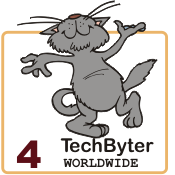 Bottom line: Ubuntu Linux is free, easy to use, and has most of the features you'll need.
Bottom line: Ubuntu Linux is free, easy to use, and has most of the features you'll need.
Every new version of Linux brings the operating system closer to the point where it could be a real contender for the dessktop. Government agencies are watching and so are business users. The trend is still slow, but it could accelerate at any time.
For more information, visit the Ubuntu website.
The Case for Electronic Publishing
When I needed to buy a reference manual for a new online application I'm using for a client, I was dismayed to find that the book cost more than $50. That's not an unreasonable price and I know it because I have some understanding of how the publishing industry works. But this is a book that will have a limited life span—maybe 2 or 3 years—and then I'll need to buy a new book for the latest version of the application. This is a dumb way to sell information. Reference manuals should be provided electronically.
I like books. They're highly portable. They offer immediate random access, particularly when used in conjunction with "bookmarks". I can add my own information by using a "pen" or a "pencil". Pretty handy, those books. But it's not the book I want. Instead, it's the information. And it's the book that causes the price of the information to be so high.
In creating a product, there are two main classifications of costs: fixed and incremental. Fixed costs are incurred whether you create 1 copy of the product or 1,000,000. They don't change. Incremental costs represent the additional cost of creating each new unit. With books, the incremental cost is what drive the price up. Maybe we don't want works of fiction to be delivered electronically just yet, and maybe not even non-fiction. But I can make a case for converting all documentation to electronic. Even if much of me would prefer the book.
Books are Dead
Young people today generally don't read for pleasure. They read what they must read and many would prefer to do that on screen. So eventually books will be replaced by electronic forms. Now is the time for that to happen with documentation for computer applications.
Consider the costs. To do that, I've created a mythical application called Grunge Puppy 4.5. It's a complex application that requires a 500-page manual with 50 10-page chapters, each written by a different subject matter expert. To create a spreadsheet that shows the equally mythical costs, I've pulled numbers out of the air. You can see the spreadsheet here (it's a PDF document).
Fixed Costs
I'm going to assume that the 50 writers will each be paid $1000 for their 10-page contributions, that a team of 3 editors will each spend 100 hours on the text (at a cost of $35 per hour, including benefits), that 2 artists (also at a cost of $35 per hour, with benefits) will spend 30 hours each creating illustrations for the book, and that 2 page-makeup specialists (aka "typesetters") will each need 8 hours (at $35 per hour, including benefits) to flow the text into a typesetting application and make it ready for the press.
These are the costs that will be borne whether the press prints 1 copy of the book or 1,000,000. The total fixed costs for this mythical book are $63,160. On a press run of 50,000 copies, this would be $1.26.
Yes, many presses really are this cheap when dealing with the people who create books. But you can double or triple the wages and still come in under $4 per book for fixed costs. The press will also have some additional fixed costs for buildings, offices, and utilities; I have not included these costs.
Incremental Costs
Now we need a mythical press run. I've decided that we'll print 50,000 copies of the book and that every single copy will sell. We're working with a printer who will create the books for $25 each and I'll figure distribution costs at $5 per book. The press will assume a 40% mark-up, which is standard. The incremental cost per book is $35, so paper, printing, and distribution cost nearly 28 times what the preparation of information cost.
Ouch! No wonder our printed book must sell for $50.
The Electronic Model
If we distribute the book electronically, we start with a cost per book of $1.26 if we assume the same 50,000 copies will sell. There will be some additional costs: A website with high security, preparation of a file that can be easily used (but that may have some copy protections built in). Let's be generous and say that this might cost $5 per copy sold.
The cost of the electronic book could be dropped to $20 ($30 less than the paper version) and the publisher would earn only slightly less profit per book.
But what if by reducing the price to $14 per book, the publisher would be able to sell 100,000 copies instead of 50,000 copies at $50 per book? In that case, the profit per book would be substantially less, but the overall net from the book would more than 21% greater based on higher volume.
The electronic model also reduces paper use and the cost of transportation, which relies largely on trucks.
Will People Accept the Change?
Initially, no. I know people who print websites to read them. I also know people who refuse to use automatic teller machines at banks. These people are part of a shrinking group. Each new generation accepts advanced technology as the way things are done. Today people are more likely to read information online (or at least on a computer screen) than on paper. ATMs (or, increasingly, online) are the only methods many people know or will use to deal with their banks.
As I said, books are dead.
More Spams I Won't Be Opening
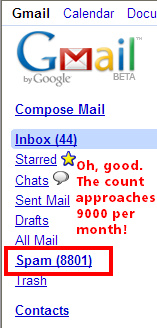 My monthly spam count is now up to nearly 9000 for the previous 30 days. I see very little of the slop, but I do look through the list once every week or so to see what the current trends are (lots of people are being "caught naked" now) and to identify messages that I can make fun of. In one case, I looked just at subject lines from the perspective of identifying which messages I wouldn't open even if the spam catcher had missed it and put the message in my in box. Here are a few from Monday morning:
My monthly spam count is now up to nearly 9000 for the previous 30 days. I see very little of the slop, but I do look through the list once every week or so to see what the current trends are (lots of people are being "caught naked" now) and to identify messages that I can make fun of. In one case, I looked just at subject lines from the perspective of identifying which messages I wouldn't open even if the spam catcher had missed it and put the message in my in box. Here are a few from Monday morning:
- See for yourself for only a buck (I'd rather see my buck.)
- Delicate craftsmanship watch rep1!c@s (If you can build a watch, you should be able to spell "replicas".)
- !=0G0;0 =0CG8B5AL ?@>4020BL... (Same to you, fella.)
- No test, No class, buy yourself Bacheelor/MasteerMBA/Doctoraate (Definitely no class. You can't even spell the name of the degree?)
- Your naked video william.blinn (I don't think so.)
- Your naked video webwonk (I really don't think so.)
- Get a complimentary 2007 personal forecast from Bethea Jenner (I can already see the future: I will not be opening this message.)
- Fell your self safe and sound with our medicines. (I'm not sure about this, but I'm fairly certain that I don't want to "fell" myself. Or even "my self".)
- Ladies and Gentlemen’s please welcome her majesty Pharmacy! (Somehow the plural possessive seems out of place here, along with the queen and her "Pharmacy".)
- Is your bikini body ready? (No, and neither is my bikini.)
- Exclusive Substance Satisfactions (I am satisfied with my substance, thank you.)
- Dear any.non.registrar.mail.is.spam@blinn.com May 89% 0FF (You've used my magic address that tells me what it is.)
The Grass is Always Greener
 Here's a garden variety spam that's either a click-fraud operation or a clueless mass marketer. Patch Perfect appears to be an actual product that's advertised on late-night television ("But wait! There's more!"). I have no idea how effective it is. But I do know that the spam wasn't very effective, except for me to ridicule.
Here's a garden variety spam that's either a click-fraud operation or a clueless mass marketer. Patch Perfect appears to be an actual product that's advertised on late-night television ("But wait! There's more!"). I have no idea how effective it is. But I do know that the spam wasn't very effective, except for me to ridicule.
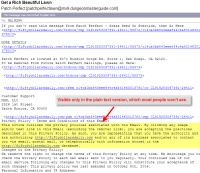 At the right is the HTML version of the spam. You'll notice that it doesn't mention anything about giving the sender permission to do anything. No, that's all hidden behind the scenes in the text version shown at the left.
At the right is the HTML version of the spam. You'll notice that it doesn't mention anything about giving the sender permission to do anything. No, that's all hidden behind the scenes in the text version shown at the left.
Here's what the hidden text says: This notice outlines the privacy policies associated with his Email. By clicking any image and/or text link in this Email (excluding the removal link), you are accepting the practices described in this Privacy Policy. As such, you are representing that you have the authority and are authorizing http://fiftydollarsdaily.com and/or any of its business associates to contact you via email, postal mail, or telephonically with information stored in the http://fiftydollarsdaily.com database. So if you click any link whatsoever, you'll just have given "FiftyDollarsDaily.com" permission to call you, send you e-mail, and send you postal mail. There's a word for this. That word is "fraudulent".
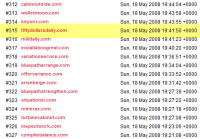 I did a bit of research on FiftyDollarsDaily and found that the organization's website is "under construction" and a bit of additional research reveals that the operation is on real-time blacklists as a confirmed spamming operation, but not a very good one. It's all the way down at #315 on the list.
I did a bit of research on FiftyDollarsDaily and found that the organization's website is "under construction" and a bit of additional research reveals that the operation is on real-time blacklists as a confirmed spamming operation, but not a very good one. It's all the way down at #315 on the list.
And the organization either doesn't quite understand how e-mail works or it's more interested in making sure it doesn't hear from anyone who wants to opt out: "If you have any questions about this Privacy Policy, please email us at privacy(at)http://fiftydollarsdaily.com, or by sending a letter to: Privacy, 2526 1st Street, Santa Monica, CA, 90405." E-mail addresses don't contain "http://".
As for the postal address: It doesn't exist. I first tried Google Maps and learned that what would be (or might have been one day) First Street is actually Main Street or Ocean Avenue (or possibly the Pacific Coast Highway) in Santa Monica. To confirm that the address doesn't exist, I tried the US Postal Service. The address does not exist. There's a word for this, too: Fraud.
Nerdly News
Firefox 3 Release Candidate 1 is Out
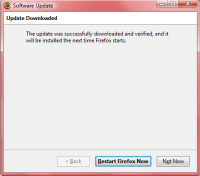
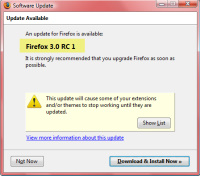 Ready, Set, Firefox! My favorite browser continues to be Firefox because it makes possible the development of plug-ins or add-ons (depending on whether you want to use the traditional term or the new dumbed-down term). Microsoft's browser offers plug-ins, too, but most of them aren't free. One of the Windows-centric magazines recently did an article called Ten IE PlugIns that Don't Suck. They ruled out useless plug-ins and ones that users have to pay for, and they came up with 10 that might be worth installing. Firefox has hundreds of plug-ins and I would be ill-at-ease if I had to give up some of them. When Firefox 3 Beta 5 became available, I loaded it. On Thursday, May 22, Firefox 3 RC1 became available. Only a few reasons remain not to upgrade.
Ready, Set, Firefox! My favorite browser continues to be Firefox because it makes possible the development of plug-ins or add-ons (depending on whether you want to use the traditional term or the new dumbed-down term). Microsoft's browser offers plug-ins, too, but most of them aren't free. One of the Windows-centric magazines recently did an article called Ten IE PlugIns that Don't Suck. They ruled out useless plug-ins and ones that users have to pay for, and they came up with 10 that might be worth installing. Firefox has hundreds of plug-ins and I would be ill-at-ease if I had to give up some of them. When Firefox 3 Beta 5 became available, I loaded it. On Thursday, May 22, Firefox 3 RC1 became available. Only a few reasons remain not to upgrade.

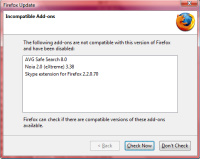 One of those reasons is that LogMeIn's plug-in doesn't work in this version. I have to use a generic viewer when I want to connect to my office machine and that generic viewer is more than lame. It's horrid. Other reasons not to upgrade yet would be any plug-in that specifically does not work with Firefox 3. When you upgrade, you'll see error messages from a lot of add-ons that aren't certified to work with the latest version, but most will once you wave the Nightly Tester Tool over them.
One of those reasons is that LogMeIn's plug-in doesn't work in this version. I have to use a generic viewer when I want to connect to my office machine and that generic viewer is more than lame. It's horrid. Other reasons not to upgrade yet would be any plug-in that specifically does not work with Firefox 3. When you upgrade, you'll see error messages from a lot of add-ons that aren't certified to work with the latest version, but most will once you wave the Nightly Tester Tool over them.
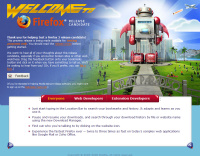
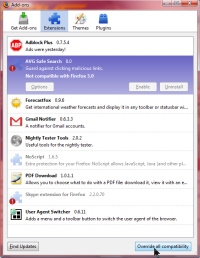 After upgrading, you'll see the usual new-version screen from the Mozilla folks. After that, you'll need to run the Nightly Tester Tools to fix the settings for plug-ins that think they're not compatible with this version. Most are compatible, but you may have one that will cause Firefox to crash.
After upgrading, you'll see the usual new-version screen from the Mozilla folks. After that, you'll need to run the Nightly Tester Tools to fix the settings for plug-ins that think they're not compatible with this version. Most are compatible, but you may have one that will cause Firefox to crash.
If this is the case, you'll need to start Firefox in safe mode (there's a Start Menu option for doing this) and disable half of the plug-ins. If the problem persists when you start Firefox again, the trouble is with one of the plug-ins in the group you left enabled. Disable half of those and start again. In other words, it's a standard binary debugging process.
As I mentioned a few weeks ago, the Mozilla Organization describes the features that are new to version 3 of Firefox: Firefox 3 is based on the Gecko 1.9 Web rendering platform, which has been under development for the past 32 months. Building on the previous release, Gecko 1.9 has more than 12,000 updates including some major re-architecting to provide improved performance, stability, rendering correctness, and code simplification and sustainability. Firefox 3 has been built on top of this new platform resulting in a more secure, easier to use, more personal product with a lot more under the hood to offer website and Firefox add-on developers.
If you're still using a browser other than Firefox, now is the time to take a look at Firefox. Really. See the previous program for more information about what the developers have been up to.
Forward This Message to 10,000 People ...
... and Bill Gates will pay you 45 cents. Or something like that. I couldn't get that out of my mind when I read the latest Microsoft ploy to bribe users. Microsoft says that it can offer rebates to people who use its search application to find and buy some products. In other words, Microsoft, with less than 10% of the search engine market share, hopes to beat Google by buying customers.
The other thing I can't get out of my mind is "backfire".
Live Search Cashback puts the focus on products that users buy online. According to Bill Gates, it's a big part of the $20 billion search market,” and Microsoft wants a piece of the action.
Live Search Cashback has Microsoft putting its money where its search engine is. Compared to Microsoft's less than 10% of the market, Google has nearly 62% and the percentage is increasing. Don't count Microsoft out, though. When Word had a small faction of the word processor market, Microsoft kept plugging away and put WordPerfect out of business. But it's going to be an uphill battle. Microsoft is in the also-ran position with its 10% share. Second place is held by Yahoo with about 20% of the search market.
Microsoft says it has signed up 700 merchants who sell more than 10,000,000 products. Microsoft will determine the amount of the rebate shoppers will earn and they're not very large. In most cases, the discounts are in the range of 2 to 5 percent. Will the average user who's looking for a digital SLR camera be willing to use Microsoft's search to net $20 to $50 in savings? Maybe. But what about people who are looking for something in the $100 to $500 range where the possible extra savings might be no more than $2?
The Weekly Podcast
Podcasts are usually in place no later than 9am (Eastern time) on the date of the program. The podcast that corresponds to this program is below. The most recent complete podcast is always located here.
Search this site: Looking for something you remember hearing about on TechByter Worldwide? Search me.
Subscribe to the newsletter: Subscribing to the podcast: I recommend Apple's Itunes for podcasts. Itunes will also install the latest version of QuickTime. The program is free. Need instructions?
Privacy Guarantee: I will not sell, rent, loan, auction, trade, or do anything else with your e-mail address. Period.
How the cat rating scale works.
Do you use a pop-up blocker? If so, please read this.
The author's image: It's that photo over at the right. This explains why TechByter Worldwide was never on television, doesn't it?
Feed the kitty: That's one of them on the left. Creating the information for each week's TechByter requires many hours of unpaid work. If you find the information helpful, please consider a contribution. (Think "NPR".)


